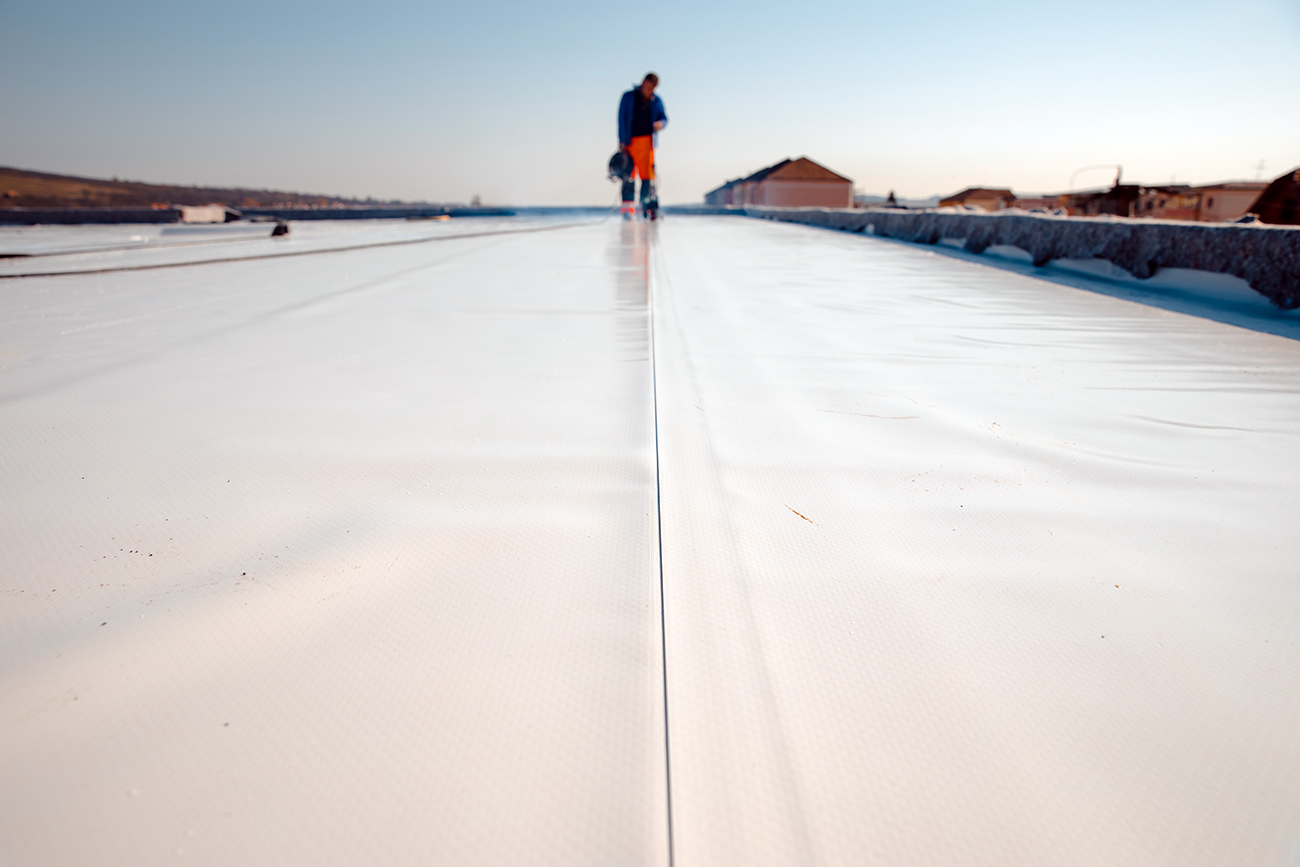
What Is TPO Roofing and Is It Right For Your Property?
Are you a property owner in the New Orleans area considering a new roofing system for your building? With so many options available, it can be tough to know which material is the best fit for your needs and budget. One increasingly popular choice, especially for commercial properties, is TPO roofing. But what exactly is TPO roofing, and why might it be the ideal solution for your next roofing project? In this comprehensive guide, we’ll dive into everything you need to know about TPO roofing – from its composition and benefits to installation and maintenance tips. By the end, you’ll have a clear understanding of whether a TPO roof is right for your New Orleans property.
What is TPO Roofing?
TPO, or thermoplastic polyolefin, is a single-ply roofing membrane that has gained significant traction in the commercial roofing market over the past few decades. TPO roofing is made from a blend of polypropylene and ethylene propylene rubber, which are combined to create a durable, flexible, and UV-resistant material. A typical TPO roofing system consists of the TPO membrane, which is available in various thicknesses (usually 45, 60, or 80 mils), along with an insulation layer and appropriate adhesives or fasteners.
One of the key advantages of TPO is its heat-welded seams. During installation, the edges of adjacent TPO sheets are heated and fused together, creating a virtually impenetrable bond that is stronger than the membrane itself. This heat-welding process results in a roofing system with exceptional water resistance and overall durability.
Compared to other single-ply roofing membranes like PVC (polyvinyl chloride) and EPDM (ethylene propylene diene monomer), TPO offers a balance of performance and affordability. While PVC is known for its superior chemical resistance and EPDM for its excellent weatherability, TPO combines many of the best attributes of both materials at a more cost-effective price point. This has contributed to the rapid growth and adoption of TPO in the commercial roofing industry.
Benefits of TPO Roofing
There are numerous reasons why property owners and roofing contractors alike are turning to TPO for their roofing needs. Some of the most notable benefits include:
1. Durability: TPO roofing systems are built to last. With proper installation and maintenance, a TPO roof can have a lifespan of 20-30 years or more. The material’s inherent flexibility allows it to withstand the expansion and contraction caused by temperature fluctuations, while its robust chemical structure resists damage from UV rays, ozone, and other environmental stressors.
2. Strength: The heat-welded seams used in TPO roofing installation create a monolithic, almost indestructible bond. This, combined with the puncture- and tear-resistant properties of the TPO membrane itself, results in a roofing system that can stand up to heavy foot traffic, severe weather events, and even minor impacts from falling debris.
3. Energy Efficiency: TPO roofing is available in white and other light, reflective colors that can help reduce cooling costs by reflecting the sun’s heat away from the building. This not only leads to lower energy bills but can also minimize the urban heat island effect and contribute to a more sustainable built environment. Many TPO membranes are ENERGY STAR® qualified and can help buildings earn points toward LEED® certification.
4. Cost-Effectiveness: Compared to other commercial roofing materials, such as built-up roofing (BUR) or modified bitumen, TPO offers an attractive combination of performance and value. The material itself is less expensive than PVC, and the installation process is often quicker and more straightforward, which can translate to lower labor costs. Over the life of the roof, the energy savings and durability of TPO can result in a lower total cost of ownership.
5. Environmental Friendliness: TPO is an environmentally friendly roofing choice for several reasons. First, the reflective properties of the membrane can reduce the building’s energy consumption and associated greenhouse gas emissions. Second, TPO is fully recyclable at the end of its service life, meaning it won’t contribute to the growing problem of construction waste in landfills. Finally, many TPO roofing systems can be installed directly over existing roof substrates, minimizing the need for tear-offs and reducing the environmental impact of the roofing project.
The TPO Roof Installation Process
Proper installation is critical to the long-term performance and durability of any roofing system, and TPO is no exception. The first step in the TPO roofing installation process is to prepare the roof deck or substrate. TPO can be installed over various substrates, including concrete, wood, metal, and even existing roofing materials (in some cases). The surface must be clean, dry, and free of debris before installation can begin.
Next, the insulation layer is installed. TPO roofing systems typically use polyisocyanurate (polyiso) insulation, which offers excellent thermal performance and dimensional stability. The insulation boards are secured to the roof deck using mechanical fasteners or adhesives, depending on the specific project requirements and local building codes.
Once the insulation is in place, the TPO roofing membrane is rolled out and positioned on the roof. The membrane can be fully adhered, mechanically fastened, or ballasted, depending on factors such as the roof slope, wind uplift requirements, and building use. In a fully adhered system, the TPO membrane is bonded to the insulation layer using a special adhesive. Mechanically fastened systems use screws and plates to secure the TPO roofing material at the seams and along the perimeter. Ballasted systems rely on the weight of gravel or pavers to hold the membrane in place.
Regardless of the attachment method, the seams between adjacent TPO sheets are then heat-welded using a hot air gun or robotic welding machine. This process involves melting the edges of the sheets and pressing them together to create a permanent, watertight bond. Proper heat-welding is essential to the integrity of the roofing system, so it should only be performed by trained and experienced professionals.
After the TPO membrane is fully installed and the seams are welded, the TPO roofing contractor will install any necessary flashings, edge metal, and other accessories to complete the system. The entire installation process typically takes several days to a few weeks, depending on the size and complexity of the project.
When is TPO Roofing the Best Option?
TPO roofing is an excellent choice for a wide range of commercial and residential applications, but it is particularly well-suited for certain types of projects. One of the most common uses for TPO is on low-slope or flat roofs. The material’s excellent water resistance and heat-welded seams make it an ideal solution for roofs with minimal pitch, where ponding water and leaks can be a concern with other roofing materials.
TPO is also a popular choice for both new construction and re-roofing applications. In new construction, TPO can be easily integrated with other building components and can help the project achieve energy efficiency and sustainability goals. For re-roofing projects, TPO’s lightweight and flexible nature make it possible to install directly over some existing roofing materials, saving time and money on tear-offs and disposal.
Another situation where TPO roofing shines is on large commercial or industrial facilities. The material’s cost-effectiveness and quick installation process can be a significant advantage on expansive roof areas, such as warehouses, manufacturing plants, or shopping centers. TPO’s energy-saving properties can also have a meaningful impact on these types of facilities, where cooling costs can be a major expense.
Finally, TPO is an increasingly popular choice for green building projects and environmentally conscious property owners. The membrane’s reflective surface can help mitigate the urban heat island effect and reduce the building’s carbon footprint, while its recyclability and low environmental impact during installation make it a more sustainable choice than many traditional roofing materials.
TPO vs. Other Roofing Materials
When considering TPO roofing for your New Orleans property, it’s important to understand how it compares to other common roofing materials. One of the most significant advantages of TPO over traditional built-up roofing (BUR) and modified bitumen systems is its ease of installation. TPO is lightweight and can be installed quickly with minimal disruption to building operations, whereas BUR and modified bitumen require multiple layers and hot asphalt or torch application, which can be time-consuming and hazardous.
Compared to other single-ply membranes like EPDM and PVC, TPO offers a balance of performance and cost. EPDM is known for its excellent durability and weather resistance, but it lacks the heat-welded seams and reflective properties of TPO. PVC, on the other hand, offers superior chemical resistance and can be heat-welded like TPO, but it is often more expensive and can become brittle over time.
When choosing between TPO and other roofing materials, it’s essential to consider factors such as the building’s use, location, and budget. For example, if chemical exposure is a major concern (e.g., in a manufacturing facility), PVC may be the better choice. If the building is located in an area with extreme temperatures and UV exposure, EPDM’s weatherability might be a deciding factor. However, for most commercial properties in the New Orleans area, TPO offers an attractive combination of durability, energy efficiency, and value.
How to Maintain a TPO Roof
While TPO roofing is known for its low maintenance requirements, regular inspections and proper care are still essential to maximizing its lifespan and performance. Building owners should schedule professional roof inspections at least twice a year, as well as after any major weather events or construction activities.
During these inspections, the roofing contractor will look for signs of damage or wear, such as punctures, tears, or seam failure. They will also check for ponding water, which can accelerate the deterioration of the membrane and lead to leaks if left unaddressed. Any debris or vegetation growth on the roof should be removed promptly to prevent damage and ensure proper drainage.
To keep the TPO membrane clean and in good condition, building owners can use a soft-bristled brush or pressure washer (on a low setting) to remove dirt, algae, or other accumulations. Harsh chemicals or abrasive cleaning methods should be avoided, as they can damage the membrane and void the manufacturer’s warranty.
If damage or leaks are detected, it’s crucial to address them promptly to prevent further deterioration and protect the building’s interior. Small punctures or tears can often be repaired with TPO patch kits, while more extensive damage may require the replacement of individual membrane sheets. In some cases, a complete roof replacement may be necessary if the damage is widespread or the roof is nearing the end of its service life.
By following these maintenance tips and working with a trusted local roofing contractor, New Orleans property owners can extend the life of their TPO roofs and enjoy the benefits of this durable, energy-efficient roofing system for decades to come.
TPO Roofing in New Orleans
The unique climate and weather conditions in New Orleans make TPO roofing an excellent choice for many commercial and residential properties in the area. With its hot, humid summers and frequent rainfall, the city can put significant stress on roofing systems. TPO’s heat-welded seams and excellent water resistance make it well-suited to withstand these challenges, while its reflective surface can help keep buildings cool and reduce energy costs during the sweltering summer months.
In addition to its performance benefits, TPO roofing has been used successfully on numerous projects throughout the New Orleans area. For example, the New Orleans Ernest N. Morial Convention Center, one of the largest convention centers in the United States, features a massive TPO roofing system that has provided reliable protection and energy savings for years. Many other commercial buildings, schools, and hospitals in the region have also turned to TPO for its durability, cost-effectiveness, and sustainability.
Investing in a TPO Roof for Your Property
In conclusion, TPO roofing has emerged as a smart choice for property owners seeking a roofing system that offers the perfect balance of durability, energy efficiency, and affordability. As the roofing industry continues to evolve and place greater emphasis on sustainable, high-performing materials, TPO has proven itself to be a solution that meets and exceeds these expectations.
For property owners in the New Orleans area, TPO roofing offers a particularly compelling value proposition. Its ability to withstand the region’s harsh climate, resist damage from UV radiation and weathering, and provide long-lasting protection makes it an ideal choice for commercial and residential buildings alike. Moreover, its reflective properties and potential for energy savings align well with the growing focus on sustainability and green building practices.
With its impressive track record and growing popularity, TPO has demonstrated its value as a roofing material that delivers both short-term and long-term benefits.
Ultimately, investing in a TPO roof is a decision that can provide property owners with peace of mind, knowing that they have chosen a durable, energy-efficient, and cost-effective solution for protecting their building and its occupants. As the roofing industry continues to advance and prioritize materials that offer the best combination of performance, sustainability, and value, TPO is well-positioned to remain a top choice for discerning property owners in New Orleans and beyond.
Frequently Asked Questions About TPO Roofing
How long will a TPO roof last?
With proper installation and maintenance, a TPO roof can last 20-30 years or more. Factors such as the thickness of the membrane, the quality of the installation, and the level of maintenance provided can all impact the longevity of the roof.
Which is better, TPO or EPDM roofing?
Both TPO and EPDM have their advantages, and the best choice will depend on the specific needs of the building and the preferences of the owner. TPO offers heat-welded seams, reflective properties, and a balance of durability and affordability, while EPDM is known for its exceptional weatherability and resistance to extreme temperatures. A qualified roofing contractor can help determine which material is best suited for a particular project.
Is TPO roofing waterproof?
Yes, TPO roofing is designed to be fully waterproof when properly installed and maintained. The heat-welded seams create a monolithic, impermeable barrier that prevents water from penetrating the roof system. However, regular inspections and prompt repairs are necessary to maintain the roof’s watertight integrity over time.


